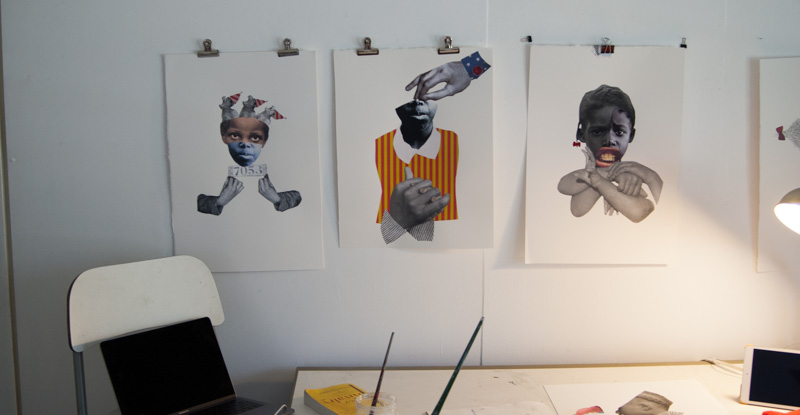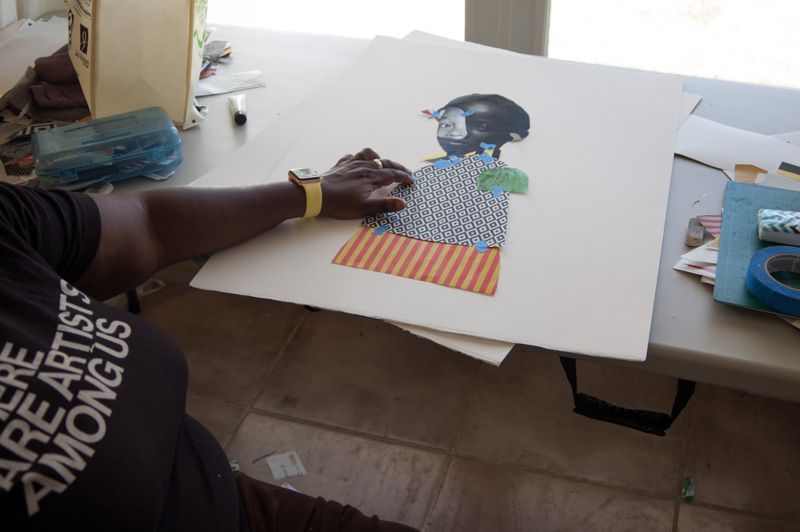What really struck me from my first live viewing of Deborah Roberts collages at the Untitled Art Fair, Miami Art Week, December, 2018, was the reflection of my sister when she was just a young girl. I remember her expressive self and playful attitude from those days. She’s younger than me so those were my youthful eyes looking back at another young being as well.

Ms. Roberts is purposefully investing her art with that vivacious energy that comes from youth. It’s joyous and yet, at times, painful to grow up a black female child in the “America” (my quotes: see below).
She started making collage works about twelve years ago after being primarily a painter. She says that creating with collage wasn’t realized in her practice until arriving at Syracuse University. She only recently completed her MFA making this newer visual language her most current.
She creates her collages by using images of young girls, including body parts (hands, arms, and legs) and bits and pieces of other things such as of textures and textiles. At times she has a specific set of ideas that she explores but at other times she sets herself free and just creates small pieces to loosen her chops and experiment. Her figures don’t normally come from magazines but other sources that she reproduces and cuts up.
The faces she uses are of little girls in Africa and Haiti. Ms. Roberts finds a resonance with the innocence of the youthful face that is important in her mashups with the pointed gestures of hands, arms and body posture.These are faces that have not been obviously touched by pop culture and the pressure to measure oneself by European standards of beauty with no makeup and natural hair. There is also a sense of freedom at 7-8 years old to be who you are and dream of life’s possibilities in a positive sense.
The young girls are sophisticated and even gestural in the ways of dancers with elegance and suave. They can hold up their heads and be self confidently strong and intact. In some ways, they seem as grown women in children’s bodies. The subtext of the work is much more about women than little girls, although it is wrapped together.
“As we grow into womanhood, when do we put on the gloves to protect ourselves? Is it at 8, or 14 or 21, when we can stand on our own verbally, [or] at times physically with our bodies? So, when do those gloves come on when it comes to protecting ideas about who we are?”, Deborah Roberts questions.
Roberts eventually wants to look at teens and then young adults, a way to follow the age progression of her “children.” She doesn’t want to rush into it for the sake of doing it but to do it with purpose. She thinks it might take at least a year to get the visual language right to also speak about masculinity and fragility using young boys, one of her facing challenges. These are the issues confronting her practice.

(Deborah Roberts relaxed and in conversation)
Her focus area by age will remain with the adolescents and young adults, not taking a look at the future rather than the past, so to speak. This is the age-time of identity formation, critical to one’s becoming a complete individual. Roberts says by the time we reach 34-35 years old we finally know who we are as people. We realize by then we are not free and equal. “For me, that’s when it happened. I can’t speak for others but, for me that’s when. I was thinking we were together, black and white, ‘kumbaya,’ and at 36 yrs. things happened and I realized it was just not true.” says Roberts.
Ms. Roberts did a spread for New York Magazine where she was asked to use young adult girls and dress her in haute couture, and talk about a powerful black woman in couture clothing. She wouldn’t normally do that in her own practice she adds, but the opportunity presented to her gave her a platform for a different conversation Roberts found refreshing.
For her direction during summer of 2018 she intends to acknowledge Norman Rockwell and his figuration that is well known from Saturday Evening Post magazine. Rockwell asked “America” to invest in “America” (quotes mine). Roberts has been working with red, white, and blue reminding us that Rockwell did a similar action while asking the US to invest in war bonds and the effort of world war II. This Rockwell did with a series of posters; freedom posters. This painting series (that also became posters) has been the cornerstone of retrospective art exhibits presenting the career of Rockwell, who was the most widely known and popular commercial artist of the mid-20th century, but did not achieve critical acclaim. The paintings—Freedom of Speech, Freedom of Worship, Freedom from Want, and Freedom from Fear—are now in the Norman Rockwell Museum in Stockbridge, Massachusetts. The four freedoms refer to President Franklin D. Roosevelt’s January 1941 Four Freedoms State of the Union address in which he identified essential human rights that should be universally protected. She plans to unpack the ideas behind the four freedoms with a contemporary perspective. 2018 looks very different from 1942.
As we continue to move through 2018 we will have to remain engaged with Ms. Roberts practice as she is giving voice to the lives of our sisters, daughters and cousins, with a visual language that is poetic and powerful as it is painful (at times).
(Note: my use of “America” refers to the United States of America, only one of many American countries in its northern and southern hemispheres.)
Our conversation took place during her Fountainhead Residency in April, 2018.
